How to understand searcher intent to boost SEO rankings
SEO is one of the best ways to bring a wider audience to your blog or ecommerce storefront. It’s estimated that by 2020, business owners will spend around 82 billion dollars on their SEO marketing plan. In this sense, it’s obvious that SEO will continue to grow in popularity over the years.
We want to take a look at one of the most important aspects of search engine optimization, and that is understanding the intent of your user when they search for something online. It’s important to constantly think about the intent of your potential customers and what may drive them to your website.
Let’s explore user intent and find out how we can use this complex system to help improve your website’s ranking.
What is search intent?
Before we can dive into how to use searcher intent, it’s important to understand what we mean when we use this phrase. In a nutshell, searcher intent is the reason why someone would search for something.
Knowing the intention of your audience, and potential customers mean you’ll be able to plan ahead and pick keywords that will make them more likely to find your site while searching online. Now let’s take a look at the two major types of intent and how you can determine the best approach to your search engine optimization.
User intention types
A study out of Hong Kong called “Utilizing search intent in topic ontology-based user profile for web mining” divided the reason people search for something into two categories. You should view the first type of user intention as a wide fishing net. They are looking for something, but on a broad scale based on their keyword choice.
Here’s a great example to consider from a simple Google Search. We decided to look up “content marketing” so that we could analyze the results.
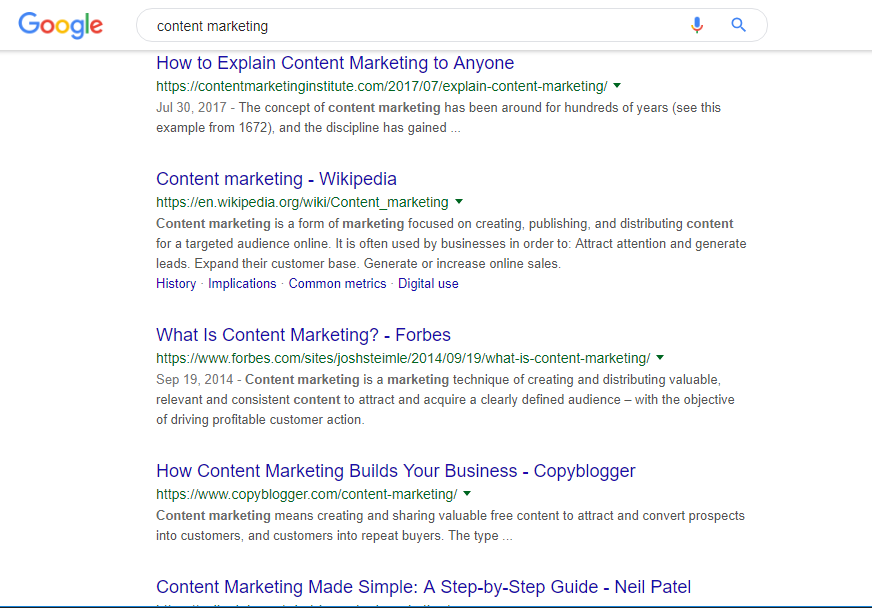
Source: Google search
Notice that there are a ton of different results here. We have the definition of content marketing, how to explain content marketing to someone else, a guide to effective content marketing, and how content marketing can effectively grow your business.
The broader the search, the more information the end user is likely looking for. You have to be willing to predict the searches potential customers may make and work towards ranking for those keywords with effective link building, content creation, building social proof, and by keeping an eye on your traffic as you implement new keywords into your website.
The second type of user intent mentioned in the Hong Kong study is a more specific, tight, and refined search. Instead of a broad net, the user is looking for something specific. If you’re able to anticipate what kind of questions, concerns, or pain points your audience is facing, you can better prepare for their searches and work on building pillars around those keywords.
Here’s an example of a specific search on Google. We looked for “how can email marketing help my business?” and this is what we found.

Source: Google search
Every single result is about the same topic, improving your business by using email marketing. In other words, the more specific the search query, the more tailored content you should make to fit that topic.
But how can we determine what someone is going to search?
Tools to improve your predictions
We all know that there are a ton of different tools designed to help you fine-tune your search engine optimization. Many business owners struggle with the idea of finding pain points and then using those problem areas as a jumping off point for better optimization.
The good news is that there are a couple of free tools available to help you come up with great ideas for keywords as well as popular topics that you can use to create your own pieces of unique content.
As far as keyword research goes, you should already have the Google Keyword Planner tool. This tool helps you determine whether a certain search is generating a lot of traffic, and how much competition there is for that particular word or phrase. Ideally, you’re going to want to pick keywords that have low competition but a high search volume.
But beyond that, there is also the task of coming up with keywords that fit the broad net approach, as well as the very specific niche topics. AnswerThePublic is a great resource for discovering keywords based on an initial search. Here’s an example of “email marketing” after the big map we will zoom in and see how you can pick quality keywords based on your user’s intent.
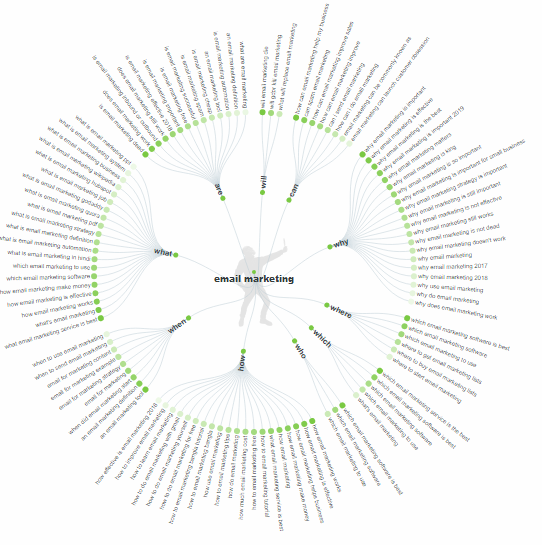
Source: AnswerThePublic
Every branch you see here is a different topic idea. It may seem overwhelming at first, but if you think about what your website does, why users may need your product and service, and what kind of problems they are encountering you’ll be able to choose the word or phrase that most likely lines up with their intent.
For example, let’s take a closer look at the “what” and “when” groups under email marketing. If you’re selling a service that helps with email marketing, which topic do you think would most align with the goal of your potential customers?
‘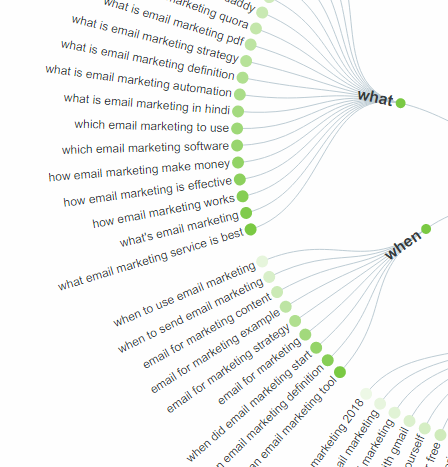
Source: AnswerThePublic
It’s pretty obvious that potential customers are going to want to know “when to use email marketing” and have no need for “what is email marketing in Hindi.” How do you know this? Well, because your business is one that focuses on helping customers with email marketing, including their strategy. The percentage of people looking to learn email marketing in Hindi versus one who just wants to know when they should use email marketing is the difference between night and day.
Tools like AnswerThePublic are great resources for those who want to expand their search reach, but not quite sure where to begin.
Conclusion
There’s no doubt that SEO is here to stay. If you want to make the most of your business it’s crucial that you think about the intent of your customers when they are using their search engines.
Try putting yourself in the shoes of a customer. What kind of questions would you have about the niche you cover (prior to finding your site.) Most importantly, you should try to think about what kind of content you can develop that will help answer those questions. The proof is in the pudding, valuable content ranks high on Google.
If you’re willing to take the time to explore your audience and their intent, as well as do everything you can to solve their problems with stellar content and smart SEO keywords, you’ll find that reaching that elusive first page of Google is not just possible, it’s probable.
Related reading
Average position is misinterpreted as a metric that shows the actual position of ads on SERPs. How to accurately gauge the true page position of your ads?
I’ll walk you through nine types of meta description tags with screenshots and examples, showing you what works well and how they could do better.
When you face a drop in your rankings or traffic, it’s just the tip of an iceberg. Discover the possible causes of a sudden drop in traffic and their fixes.
New study from Pega shows consumers don’t trust artificial intelligence
A new report released by Pega that examined consumer attitudes towards artificial intelligence indicates that despite the growing usage of AI technologies, consumers lack an understanding of how they can benefit from AI and are more likely to trust a real person to help make decisions.
“Our study found that only 25% of consumers would trust a decision made by an AI system over that of a person regarding their qualification for a bank loan,” said Dr. Rob Walker, vice president, decisioning and analytics at Pega. “Consumers likely prefer speaking to people because they have a greater degree of trust in them and believe it’s possible to influence the decision, when that’s far from the case. What’s needed is the ability for AI systems to help companies make ethical decisions. To use the same example, in addition to a bank following regulatory processes before making an offer of a loan to an individual it should also be able to determine whether or not it’s the right thing to do ethically.”
As a result of the survey’s findings, Pega announced the launch of its Customer Empathy Advisor, an AI tool that seeks to incorporate empathy and ethical-decision making in the framework of AI technologies.
Why we should care
AI and machine learning technologies are becoming increasingly more familiar to digital marketers and consumers, but the lack of trust can have a negative impact on the customer’s digital experience and ultimately, your brand’s reputation. Trust and transparency continue to be highly prioritized by consumers and touted by platforms, and AI’s imprint in the martech landscape is only going to grow. Marketers who can harness the capabilities of AI and integrate empathetic qualities and human-like characteristics should expect to see success among consumers.
As AI becomes more accessible to digital marketers, it will become more widely used by consumers. Thanks to tools like display ads featuring AI-enabled chatbots, digital marketers have more opportunities to drive personalized interactions. For teams considering implementing AI, giving customers the opportunity to choose whether if they prefer an AI-based or human-driven experience to solve their inquiry could be a step towards building trust and transparency.
More on the news
- There are serious trust issues with AI: less than half (40%) of respondents agreed that AI has the potential to improve the customer service of businesses they interact with, while less than one third (30%) felt comfortable with businesses using AI to interact with them. Only nine percent said they were ‘very comfortable’ with the idea.
- Consumers are cynical about the companies they do business with: Sixty-eight percent of respondents said that organizations have an obligation to do what is morally right for the customer, beyond what is legally required. Despite this, 65% of respondents don’t trust that companies have their best interests at heart, raising significant questions about how much trust they have in the technology businesses use to interact with them.
- Many believe that AI is unable to make unbiased decisions: Over half (53%) of respondents said it’s possible for AI to show bias in the way it makes decisions.
- People still prefer the human touch: 70% of respondents still prefer to speak to a human than an AI system or a chatbot when dealing with customer service and 69% of respondents agree they would be more inclined to tell the truth to a human than to an AI system.
- Most believe that AI does not utilize morality or empathy: Only 12% of consumers agreed that AI can tell the difference between good and evil, while over half (56%) of customers don’t believe it is possible to develop machines that behave morally. Only 12% believe they have ever interacted with a machine that has shown empathy.

6 Brilliant Reasons Why You Should Use SEO Tools via @jasonhennessey
The idea that SEO tools are useful for SEO isn’t anything groundbreaking. Most marketers know that knowledge is power and that one’s SEO knowledge is only as strong as the data it’s built on.
Having access to accurate, reliable, easy-to-use SEO tools will only make your SEO strategy stronger. You’ll gain invaluable insights into not only how your own site is performing, but also what your competitors are doing in their SEO efforts.
So let’s leapfrog the basics and get into the more brilliant reasons why you should be using SEO tools.
1. Dissect Competitor SEO Strategy
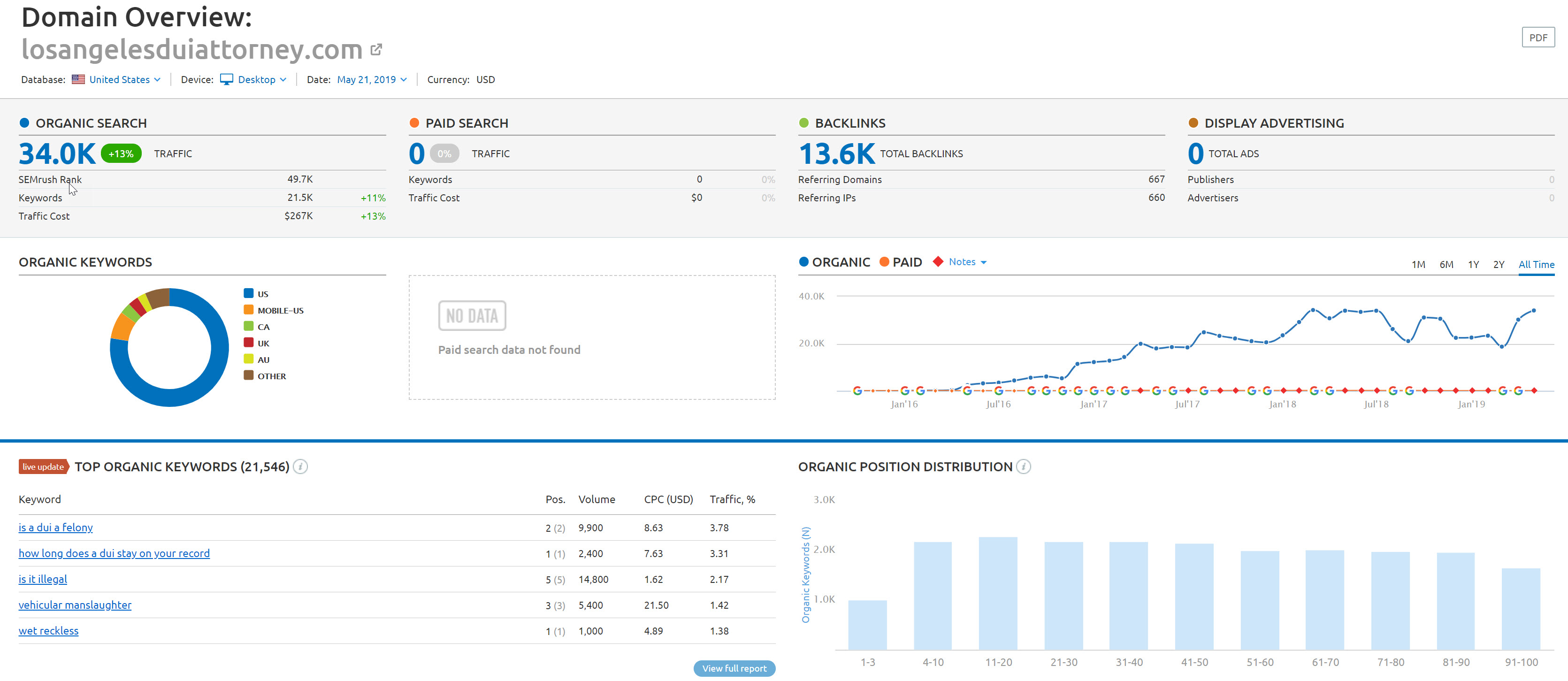

In a world full of shady marketing and SEO tactics, it can be easy to get pulled to the Dark Side. Fortunately, you can scratch that itch by spying on the competition without crossing any ethical lines.
Many SEO tools, like SEMrush or Raven Tools allow you to dig into your competition’s SEO strategy.
Not only can you see their traffic numbers and rankings, but identify where their backlinks are coming from and how their content is performing across platforms.
Backlink Profile
One of the sneakiest ways to spy on your competitors is to use SEO tools to see their backlink profile. Here, you can see what websites their backlinks are coming from, the authority of these sites, the anchor text, and much more.
Then, you can lay out a game plan for reaching out to those same sites to generate links to your own website. No need to scour the web for industry domains – you can generate a list of opportunities in a matter of seconds.
Keyword Opportunities
Generating a list of keyword opportunities can get more difficult the longer you are in the SEO game. You may have hit a wall and aren’t sure what pieces of content to build out next.
With SEO tools, you can see which new and existing keywords your competitors are ranking for. You can then add these terms to your own list, use the tools to identify related keywords, and even consider expanding to new markets.
SEO tools like SEMrush are capable of generating thousands of keyword ideas at once. Never be at a loss for blog post ideas or new web pages ever again.
2. Save Time and Money on Manual SEO Audits
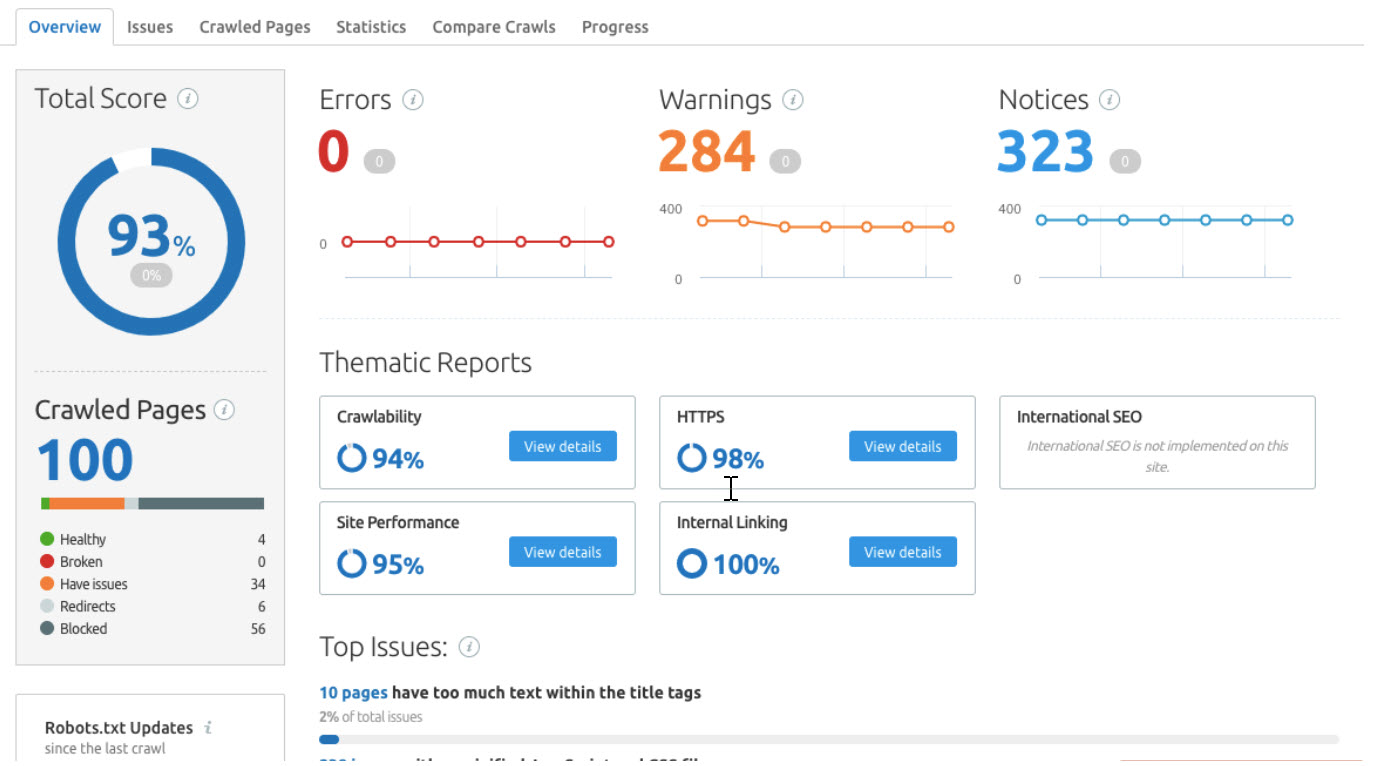

Comprehensive SEO audits deliver a wealth of knowledge when it comes to identifying website issues. Unfortunately, in-depth audits often time loads of time and money to generate by hand.
SEO tools can cut this time and cost in half while delivering the same (or better) quality of results.
Screaming Frog is a fantastic, free crawling tool that identifies loads of potential issues with your site, such as:
- Orphaned pages.
- Missing page titles.
- Missing meta descriptions.
- Broken links.
- Poor page depth.
- Page server errors.
- And more.
Other tools, like SEMrush and Majestic, automate this process completely, pulling a range of information into an easy-to-read report. You can generate these reports for yourself or your clients for as little as $100 per month.
These reports are a roadmap for what needs to be fixed on the website – from on-page SEO to content to links to load speed. Working from an SEO audit is the surest way to build a rock-solid SEO foundation for your site.
3. Find High-Converting Keywords for Content & Content Marketing
Finding the right keywords for your website is easier said than done. It’s not enough to simply identify industry terms that have decent search volume and low competition. Many other factors come into play.
For one, the intent behind the search terms users are searching for matters more than ever.
Are users looking:
- For free information?
- To solve a problem?
- To buy a product?
You will need to answer these questions.
Find Low Hanging Fruit & Keyword Variations
SEO tools help you identify keywords that you might have never thought of before. They will generate related keywords and variations that can be used in different types of content.
One way to find these is through competitor analysis. Another way is to see which terms your site is already ranking for, what position you’re ranking at, and which terms could use a boost.
Use SEO tools to find keywords that:
- Your site is already ranking for but where some added optimization could make a huge difference.
- Your site is ranking for but you don’t want to rank for, so you can move these from your strategy.
- Keywords you are performing well on and that present variations that are worth targeting.
This will inform you of whether existing content needs to be optimized or if new content needs to be added.
High-Converting Keywords
Keywords that have a buyer’s intent behind them are worth targeting, as they tend to have the highest conversion rate.
Even if you don’t aim to sell a product or service right out the gate, you can still use content to generate leads.
Target conversion-happy keywords and add content upgrades to your content to generate leads.
SEO tools can also help you identify how your competitors are conducting their content marketing.
Simply look at their highest ranking posts and/or posts with the most backlinks and see whether they are using content upgrades themselves.
SEO tools allow you to go beyond your own imagination and use the data to fuel a holistic SEO strategy.
4. Track SEO Progress & KPIs
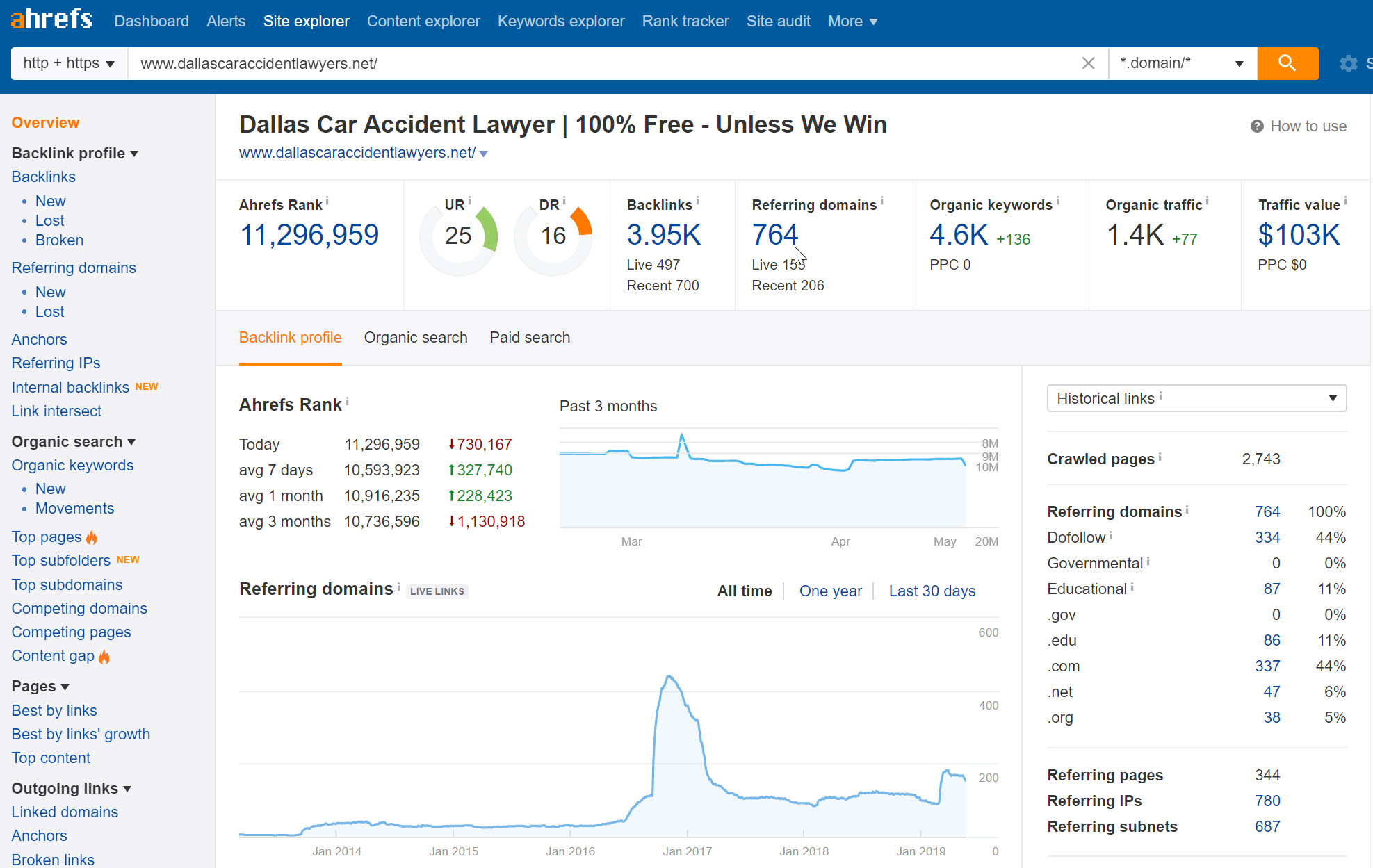

Many website owners look at their rankings as the primary measure of their SEO success. But there are many other metrics that are worth considering – primarily, organic traffic and conversions.
These can be difficult to calculate on your own. Fortunately, SEO tools make it super clear when your SEO efforts are paying off.
The key performance indicators (KPIs) you measure will depend on your goals and business model. Some of these may include:
- Keyword rankings
- Domain authority
- Number of backlinks
- Traffic
- Form fills
- Sales
- Shares
- Clicks
- Social media comments
It’s worth measuring your progress across multiple metrics and platforms to ensure that not only are you getting more traffic but that that traffic is converting.
With tools like Raven Tools, you can even track for individual keywords and monitor backlinks you are trying to acquire. You can generate reports that compare your progress period-over-period and against your competitors.
Always know if your SEO efforts are paying off. Use SEO tools to track what matters most for your website.
5. Visualize & Conceptualize Data
Believe it or not, not every SEO pro is a numbers person.
Fortunately, there are plenty of SEO tools to help you make sense of the data through data visualization.
What Is Data Visualization?
Data visualization is a way of presenting data as a graph or chart. Rather than having to decipher the meaning of numbers yourself, data visualization tools conceptualize and analyze the numbers in a way that makes sense.
This is extremely helpful if you are mapping your SEO progress over time, looking at user demographics, or are analyzing the success of your marketing campaigns.
Data Visualization with SEO Tools
Many SEO tools will generate graphical reports that allow you to see and analyze data at a glance. These can be particularly helpful for when it comes time to explaining complicated metrics to clients.
Tools like TapClicks provide robust marketing data virtualization tools that you can use to inform your SEO strategy and communicate that strategy to your clients.
6. Communicate Clear ROI to Clients
Piggybacking off of the last point, SEO tools also make it easier to showcase results to your clients.
If you are a marketer or SEO specialist, your clients want to see not only an increase in traffic but also in sales. SEO tools make it super evident what’s working and what isn’t.
The reporting options from SEMrush allow you to generate custom reports to send to your clients. Showcase KPIs, highlight the work you have done, and even add a summary of what the data means.
If you are able to articulate how many leads or how much revenue you are generating for a client as a result of their SEO investment, they are more likely to stick with you for the long haul.
It also makes it easier to position a value add or upsell to help take it to that next level.
Conclusion
SEO tools aren’t only useful for tracking your rankings or conducting keyword research.
You can gain valuable insights about your competition, how your SEO efforts are paying off, and whether you are generating a solid ROI for your clients.
With a combination of tools, you’ll be able to build your SEO strategy from the foundation up.
Know of other brilliant ways to use SEO tools?
More Resources:
Image Credits
Featured Image: Shutterstock, modified by author, May 2019
All screenshots taken by author, May 2019
Apple’s new privacy features may hamper marketers
Technology giant Apple is continuing its pro-privacy crusade, but its latest features may alienate many developers and advertisers.
With Apple’s forthcoming iOS 13, announced during its Worldwide Developers Conference on June 3, it will be easier than ever for consumers to protect their personal information and prevent third parties from exploiting user data. This places Apple in direct opposition to technology companies Google and Facebook, who have drawn user and government scrutiny over their use of consumer data.
“The fact that Apple continues to position itself toward privacy is not surprising,” said Dan Goldstein, president and owner of Page 1 Solutions, Lakewood, CO. “The company has been trending this way since Facebook got caught in its privacy scandals, and the features outlined at WWDC are another step in that path.
“Most consumers treat online ads as a nuisance, and sometimes they are,” he said. “However, targeted display advertising is a powerful tool for connecting consumers with the goods and services they care about.
“To the extent that Apple’s new data privacy features negatively impact user experience in apps offered by Google and Facebook, that may hurt advertisers and consumers alike.”
Protecting personal data
One of the most important announcements at WWDC was the debut of “Sign in with Apple,” a new way for users to log in to mobile applications and Web sites.
According to Apple, users will be able to sign in using their existing Apple ID after confirming through Face ID or Touch ID.
Apps are still able to request names and email addresses, but Apple will offer an option to create a unique, random email address that forwards messages to users’ real inboxes.
Apple’s iOS 13 will be available this fall with new privacy updates. Image credit: Apple
Ultimately, this ensures that users’ activity cannot be tracked within the app and tied to their profiles.
Sign-in options with Facebook and Google are already ubiquitous and valuable revenue streams. While these one-click options are convenient, since users do not have to create new passwords for each new application, it comes at the cost of privacy since developers are able to track individual users.
Apple will also be requiring that all third-party apps will need to include Apple sign in options to be listed on the App Store. However, developers will no longer have the ability to mine the personal data of consumers using this option for future marketing purposes.
Many luxury brands and retailers, including Dior, Gucci and Farfetch, have apps available to download through the App Store.
According to a survey from Kelton Research and SheerID, two to one consumers want brands to request consent before using their personal data. Only 8 percent are comfortable with marketers looking into social channels for individualized information such as likes and activity for promotional purposes, including discounts (see story).
Net-A-Porter recently updated its mobile offerings. Image credit: Net-A-Porter
There will be other privacy-focused updates included in the new iOS launch this fall.
HomeKit Secure Video will soon allow video feeds from third-party cameras to be encrypted and sent to iCloud. Users will also have the ability to allow apps to access their location “only once,” instead of existing options such as “always” and “when using the app.”
“I think it’s also important to recognize that users won’t have full autonomy over their data and privacy with these features,” Mr. Goldstein said. “With Sign in with Apple, for instance, Apple is still effectively managing your data.
“You may be further removed from third-party access to your information, but it’s not a ‘purely private’ experience,” he said.
Corporate criticisms
These latest features are one way that Apple is positioning itself as an outlier in the technology sector. Other big tech mainstays, including Google, Facebook and Amazon, have been criticized for lax privacy policies.
In a February 2019 report, lawmakers in the United Kingdom accused social network Facebook of violating data privacy laws.
Parliament’s Digital, Culture, Media and Sport select committee found that the platform “intentionally and knowingly” violated both data privacy and competition laws. The committee also publicly requested that social media companies be held liable for harmful content on their platforms and that political advertising laws be updated (see story).
Decreasing permanence and increasing private communication, Facebook CEO Mark Zuckerberg has detailed steps the company would like to take in the future to do what it believes will better serve its audience in a recent blog post (see story).
Amazon’s Alexa voice assistant and Echo devices have also been the subject of privacy concerns. Consumers can be weary about adding devices with microphones or a camera to their homes.
As users are increasingly calling for control over their data, Amazon is letting Echo owners delete everything that they said in a day from recordings. This command will eventually evolve to let users clear what they have just said to Alexa.
As part of this privacy move, Amazon has created a new hub for its Echo devices that enable owners to understand what information is being collected through the devices (see story).
However, advertisers have come to rely on this data to learn more about consumers. Together, connected devices, services and data are expected to drive $19 trillion in economic growth around the world over the next decade, according to projections from Cisco (see story).
“Luxury brands rely on targeting discerning customers,” Mr. Goldstein said. “Although location and demographic information can be relevant to identifying the target consumers, interest-based targeting tends to be more effective for delivering relevant ads.
“Customers who visit specific Web sites or perform certain searches related to luxury goods and services exhibit a tendency to buy them, so ads targeted to these consumers tend to convert well – all without the need to access private data,” he said.
How to master technical SEO: Six areas to attack now

Technical optimization is the core element of SEO. Technically optimized sites appeal both to search engines for being much easier to crawl and index, and to users for providing a great user experience.
It’s quite challenging to cover all the technical aspects of your site because hundreds of issues may need fixing. However, there are some areas that are extremely beneficial if got right. In this article, I will cover those you need to focus on first (plus actionable tips on how to succeed in them SEO-wise).
1. Indexing and crawlability
The first thing you want to ensure is that search engines can properly index and crawl your website. You can check the number of your site’s pages that are indexed by search engines in Google Search Console, by googling for site:domain.com or with the help of an SEO crawler like WebSite Auditor.

Source: SEO PowerSuite
In the example above, there’s an outrageous indexing gap, the number of pages indexed in Google is lagging behind the total number of pages. In order to avoid indexing gaps and improve the crawlability of your site, pay closer attention to the following issues:
Resources restricted from indexing
Remember, Google can now render all kinds of resources (HTML, CSS, and JavaScript). So if some of them are blocked from indexing, Google won’t see your pages the way they should look and won’t render them properly.
Orphan pages
These are the pages that exist on your site but are not linked to by any other page. It means they are invisible to search engines. Make sure your important pages haven’t become orphans.
Paginated content
Google has recently admitted they haven’t supported rel=next, rel-prev for quite some time and recommend going for a single-page content. Though you do not need to change anything in case you already have paginated content and it makes sense for your site, it’s advisable to make sure pagination pages can kind of stand on their own.
What to do
- Check your robots.txt file. It should not block important pages on your site.
- Double-check by crawling your site with a tool that can crawl and render all kinds of resources and find all pages.
2. Crawl budget
Crawl budget can be defined as the number of visits from a search engine bot to a site during a particular period of time. For example, if Googlebot visits your site 2.5K times per month, then 2.5K is your monthly crawl budget for Google. Though it’s not quite clear how Google assigns crawl budget to each site, there are two major theories stating that the key factors are:
- Number of internal links to a page
- Number of backlinks
Back in 2016, my team ran an experiment to check the correlation between both internal and external links and crawl stats. We created projects for 11 sites in WebSite Auditor to check the number of internal links. Next, we created projects for the same 11 sites in SEO SpyGlass to check the number of external links pointing to every page.
Then we checked the crawl statistics in the server logs to understand how often Googlebot visits each page. Using this data, we found the correlation between internal links and crawl budget to be very weak (0.154), and the correlation between external links and crawl budget to be very strong (0.978).
However, these results seem to be no longer relevant. We re-ran the same experiment last week to prove there’s no correlation between both backlinks and internal links and the crawl budget. In other words, backlinks used to play a role in increasing your crawl budget, but it doesn’t seem to be the case anymore. It means that to amplify your crawl budget, you need to use good old techniques that will make search engine spiders crawl as many pages of your site as possible and find your new content quicker.
What to do
- Make sure important pages are crawlable. Check your robots.txt, it shouldn’t block any important resources (including CSS and JavaScript).
- Avoid long redirect chains. The best practice here, no more than two redirects in a row.
- Fix broken pages. If a search bot stumbles upon a page with a 4XX/5XX status code ( 404 “not found” error, 500 “internal server” error, or any other similar error), one unit of your crawl budget goes to waste.
- Clean up your sitemap. To make your content easier to find for crawlers and users, remove 4xx pages, unnecessary redirects, non-canonical, and blocked pages.
- Disallow pages with no SEO value. Create a disallow rule for the privacy policy, old promotions, terms, and conditions, in the robots.txt file.
- Maintain internal linking efficiency. Make your site structure tree-like and shallow so that crawlers could easily access all important pages on your site.
- Cater to your URL parameters. If you have dynamic URLs leading to the same page, specify their parameters in Google Search Console > Crawl > Search Parameters.
3. Site structure
Intuitive sites feel like a piece of art. However, beyond this feeling, there is a well-thought site structure and navigation that helps users effortlessly find what they want. What’s more, creating an efficient site architecture helps bots access all the important pages on your site. To make your site structure work, focus on two crucial factors:
1. Sitemap
With the help of a sitemap, search engines find your site, read its structure, and discover fresh content.
What to do
If for some reason you don’t have a sitemap, it’s really necessary to create it and upload to Google Search Console. You can check whether it’s coded properly with the help of the W3C validator.
Keep your sitemap:
- Updated – Make changes to it when you add or remove something from the site;
- Concise – Which is under 50,000 URLs;
- Clean – Free from errors, redirects, and blocked resources.
2. Internal linking structure
Everyone knows about the benefits of external links, but most don’t pay much attention to internal links. However, savvy internal linking helps spread link juice among all pages efficiently and give a traffic boost to pages with less authority. What’s more, you can create topic clusters by interlinking related content within your site to show search engines your site’s content has high authority in a particular field.
What to do
The strategies may vary depending on your goals, but these elements are critical for any goal:
Shallow click-depth: John Mueller confirmed that the fewer clicks it takes to get to a page from your homepage, the better. Following this advice, try to keep each page up to 3 clicks away from the homepage. If you have a large site, use breadcrumbs or the internal site search.
Use of contextual links: When you create content for your site, remember including links to your pages with related content (articles, product pages, etc.) Such links usually have more SEO weight than navigational ones (those in headers or footers).
Informational anchor texts: Include keywords to the anchor texts of internal links so that they inform readers what to expect from linked content. Don’t forget to do the same for alt attributes for image links.
4. Page speed
Speed is a critical factor for the Internet of today. A one-second delay can lead to a grave traffic drop for most businesses. No surprise then that Google is also into speed. Desktop page speed has been a Google ranking factor for quite a while. In July 2018, mobile page speed became a ranking factor as well. Prior to the update, Google launched a new version of its PageSpeed Insights tool where we saw that speed was measured differently. Besides technical optimization and lab data (basically, the way a site loads in ideal conditions), Google started to use field data like loading speed of real users taken from the Chrome User Experience report.

Source: PageSpeed Insights dashboard
What’s the catch? When field data is taken into account, your lightning-fast site may be considered slow if most of your users have a slow Internet connection or old devices. At that point in time, I got curious how page speed actually influenced mobile search positions of pages. As a result, my team and I ran an experiment (before and immediately after the update) to see whether there was any correlation between page speed and pages’ positions in mobile search results.
The experiment showed the following:
- No correlation between a mobile site’s position and the site’s speed (First Contentful Paint and DOM Content Loaded);
- High correlation between site’s position and its average Page Speed Optimization Score.
It means that for the time being, it’s the level of your site’s technical optimization that matters most for your rankings. Good news is, this metric is totally under your control. Google actually provides a list of optimization tips for speeding up your site. The list is as long as 22 factors, but you do not have to fix all of them. There are usually five to six that you need to pay attention to.
What to do
While you can read how to optimize for all 22 factors here, let’s view how to deal with those that can gravely slow down pages’ rendering:
Landing page redirects: Create a responsive site; choose a redirect type suitable for your needs (permanent 301, temporary 302, JavaScript, or HTTP redirects).
Uncompressed resources: Remove unneeded resources before compression, gziping all compressible resources, using different compression techniques for different resources, etc.
Long server response time: Analyze site performance data to detect what slows it down (use tools like WebPage Test, Pingdom, GTmetrix, Chrome Dev Tools).
Absence of caching policy: Introduce a caching policy according to Google recommendations.
Unminified resources: Use minification together with compression.
Heavy images: Serve responsive images and leverage optimization techniques, such as using vector formats, web fonts instead of encoding text in an image, removing metadata, etc.
5. Mobile-friendliness
As the number of mobile searchers was growing exponentially, Google wanted to address the majority of its users and rolled out mobile-first indexing at the beginning of 2018. By the end of 2018, Google was using mobile-first indexing for over half of the pages shown in search results. A mobile-first index means that now Google crawls the web from a mobile point of view: a site’s mobile version is used for indexing and ranking even for search results shown to desktop users. In case there’s no mobile version, Googlebot will simply crawl a desktop one. It’s true that neither mobile-friendliness nor a responsive design is a prerequisite for a site to be moved to the mobile-first index. Whatever version you have, your site will be moved to the index anyway. The trick here is that this version, as it is viewed by a mobile user agent, will determine how your site ranks in both mobile and desktop search results.
What to do
If you’ve been thinking to go responsive, now is the best moment to do it, according to Google’s Trends Analyst John Mueller.
Don’t be afraid of using expandable content on mobile, such as hamburger and accordion menus, tabs, expandable boxes, and more. However, say no to intrusive interstitials.
Test your pages for mobile-friendliness with a Google Mobile-Friendly Test tool. It evaluates the site according to various usability criteria, like viewport configuration, size of text and buttons, and use of plugins
– Run an audit for your mobile site by using a custom user agent in your SEO crawler to make sure all your important pages can be reached by search engine crawlers and are free from grave errors. Pay attention to titles, H1s, structured data, and others.
– Track mobile performance of your site in Google Search Console.
6. Structured data
As Google SERPs are being enhanced visually, users are becoming rather less prone to clicking. They try to get all they need right from the page of search results without even clicking on any page. And if they click, they go for a result that caught their attention. Rich results are those that usually have the benefit of being visible with image and video carousels, rating stars, and review snippets.

Rich results require structured data implementation. Structured data is coded within the page’s markup and provides information about its content. There are about 600 types of structured data available. While not all of them can make your results rich, it improves chances to get a rich snippet in Google. What’s more, it helps crawlers understand your content better in terms of categories and subcategories (for instance, book, answer, recipe, map) Still, there are about 30 different types of rich results that are powered by schema markup. Let’s see how to get them.
What to do
- Go to schema.org and choose those schemas suitable for content on your site. Assign those schemas to URLs.
- Create structured data markup. Don’t worry, you do not need developer skills to do that. Use Google’s Structured Data Markup Helper that will guide you through the process. Then test your markup in Structured Data Testing Tool or in its updated version, Rich Results Testing Tool. Keep in mind that Google supports structured data in 3 formats: JSON-LD, Microdata, and RDFa, with JSON-LD being the recommended one.
Don’t expect Google to display your enhanced results right away. It can take a few weeks, so use Fetch as Google in the search console to make your pages to be recrawled faster. Bear in mind that Google can decide not to show them at all if they do not meet the guidelines.
Don’t be surprised if you get a rich snippet without structured data implementation. John Mueller confirmed that sometimes your content is enough to produce rich results.
Summary
Technical SEO is something you cannot do without if you’d like to see your site rank higher in search results. While there are numerous technical elements that need your attention, the major areas to focus on for max ranking pay-off are loading speed, crawlability issues, site structure, and mobile-friendliness.
Aleh is the Founder and CMO at SEO PowerSuite and Awario. He can be found on Twitter at .
Related reading
I’ll walk you through nine types of meta description tags with screenshots and examples, showing you what works well and how they could do better.
When you face a drop in your rankings or traffic, it’s just the tip of an iceberg. Discover the possible causes of a sudden drop in traffic and their fixes.
GDS, a free dashboard-style reporting tool launched in June 2016 allows data import from over 100 third-party sources. Updates listed with screenshots.
Your exclusive MarTech agenda sneak peek

Over the past few weeks, senior-level marketers like you have told us the workplace challenges and pain points they’ve faced… and the creative and practical solutions they’ve devised to overcome them.
Those journeys are the foundation of the newly redesigned MarTech® agenda.
Marketing experts of all stripes will tackle some of the most vexing aspects of marketing operations and technology September 16-18 in Boston. Here’s a look at what’s in store:
On building collaborative and successful teams…
- How To Organize And Coach Outstanding Marketing Operations Teams, with Kimi Corrigan — Head of Marketing Operations, Duo Security at Cisco
- From Wild West To Business Best: Tales Of A New Martech Team, with Shannon Renz — Director of Marketing Technology, SAP Concur and Emily Cnossen, Martech Specialist, SAP Concur
- Rising To A New Martech Leadership Challenge And Building The Team That Will Help You Soar, with Erica Seidel — Founder & Executive Recruiter, The Connective Good and Dave Hsu — Global VP, Marketing Data & Technology, SAP Concur
- An SEO Framework For Marketing Operations & Technology Leadership, with Jessica Bowman — Author, The SEO Executive Playbook
On maintaining a thriving stack…
- Migration Machine: How PTC Integrated Martech Stacks Of 6 Company Acquisitions In 3 Years, with Patrick Slavin — Director, Web Strategy and Marketing Technology, PTC
- Securing Your Martech Stack: Partnering With IT And Enterprise Security, with Jorge Garcia — Sr. Manager, Marketing Technology, Akamai
On delighting customers…
- Outside-In, CX-Led Architectures To Drive Digital Transformations, with Henry Hernandez-Reveron — Technology Director, AKQA
- Putting The Customer In Custom Objects, with Justin Sharaf — Director, Marketing Technology and Operations, LogMeIn
… and that’s just the beginning. Stay tuned for the official agenda launch next week.
Ready to register? Secure your pass now and enjoy up to $900 off on-site rates!
Pssst… Attend with your team to boost company morale, cover more ground, and get your crew on the same page. Enjoy special discounts when you register as a group.
Opinions expressed in this article are those of the guest author and not necessarily Marketing Land. Staff authors are listed here.

Podcast SEO 101: How to optimize your podcast for search engines

Podcasts have turned into a very popular option for content consumption. They are not new as a form of content type but there is an increasing number of people re-discovering them. They can actually make an interesting medium to explore when trying to grow your audience.
“Podcast SEO” is expected to be a growing term among SEO professionals, marketers, and podcast hosts over the next few years.
What do we mean by “podcast SEO” and how can you really optimize your podcast for search engines?
Here is everything you need to know.
Podcasts show up in Google searches
Google has announced earlier this year that podcasts will start showing up in search results.
You will be able to search for a podcast and find some of the episodes straight through the search results. The indexing of the podcast will return the audio content that you can consume directly.
There is also the potential for Google and its services to analyze the audio and automatically transcribe it to highlight a podcast in relevant search results.
What’s interesting is that Google Podcasts has recently started automatically transcribing the podcasts to use the content as metadata. Thus, people are able to find specific information as part of an episode without even knowing about the podcast before.
This is a big moment for anyone interested in SEO to understand that podcasts are becoming more important. With Google’s support, there is a clear indication that podcasts cannot be ignored as a source of content.
“Podcast SEO” is now a growing term and there is a great opportunity for successful podcasts to build their audience through search traffic.
Thinking of SEO when structuring an episode
How do these changes from Google affect your podcast? A good starting point is to think of your content structure.
A podcast can sometimes feel like a casual conversation but it still has a structure and a theme. Whether you’re producing formal or casual content, you want to be able to have a clear theme.
Think of what you want to talk about and how the questions can maintain a good flow.
It will be easier for Google to understand the content of your podcast and how to index it if you start thinking of your audience, and what they expect from you.
Moreover, a clear theme also helps your listeners understand your main focus without getting lost in the conversation.
Creating a site for your podcast
You don’t necessarily need a site to start your own podcast. All you need is a hosting provider. However, if you want to start thinking of SEO more seriously, you want to be certain that you own the data and the relationship with your subscribers.
You can also build an email list to grow your most loyal listeners.
A site can also help you improve your podcast’s SEO. It’s easier for search engines to discover your episodes when you provide additional context to them.
Many podcasts publish a new blog post for every new episode to describe their new topic. It’s a great way to build up the content for your podcast and make it easier for search engines to pick up the main theme and the focus keywords.
You can also treat your blog content as any other regular blog post to link from one episode to the other, add related posts, and keep your audience engaged.
Adding keywords to your podcast episodes
Your podcast’s title is your number one keyword. However, you won’t just rank for it once you create more episodes so you want to make sure that you increase your chances of building your audience.
When creating content for your podcast you want to pick one main keyword that will describe it. Think of your theme, the episode’s structure, and find the best keyword to describe it.
Make sure that you don’t pick the same keyword on every episode as you risk cannibalizing your own success. Even if there is a similarity from one keyword to another, it is still important to aim for one keyword per episode.
Your keyword should have a high search volume and ideally a low competition. You can aim for long tail keywords and you can find inspiration by searching in Google or through the use of tools like Ubersuggest.
Decide on the episode titles
Your podcast titles will determine whether your potential audience will spend the time to listen to your episodes.
Even when someone discovers your podcast, they won’t necessarily listen to every single episode if the titles aren’t appealing enough.
Your titles should be clear and descriptive while taking into consideration the limitation of characters.
A keyword can also be helpful in the episode’s title but you still want to make sure that you add it in context with the rest of the content.
Should you include the episode’s transcript?
Google may have just started automatically transcribing the podcasts but they are not yet perfect.
A transcription of your episode can help search engines understand your podcast in more detail.
It can improve the discoverability of the episode through the right focus on keywords, content structure, and key topics.
A transcription also makes your podcast more accessible to people and you can even split the topics that you’re talking about in time brackets to help everyone find them easily in your podcast.
Podcast transcriptions can be time-consuming though and not every podcast host might be ready for this step. If you’re serious about building your audience and improving your SEO, even in the longer term, it might be worth the effort.
Metadata
As with every other practice of SEO, metadata can provide additional details about your content.
A podcast’s description can explain what the episode is about. It should provide further information right after the title. The description is also helpful for search optimization to allow search engines to understand the topic of your episode. You can also add your main keyword to ensure that you are consistent with it.
Tags are also useful for your podcast. They allow people to discover them by looking at specific categories or genres. You can add several tags but you want to make sure that they are still somehow relevant to your podcast.
Think of your potential audience and what they should search to discover your podcast.
Link to your podcast on social media
Sharing is caring. A good indication of a podcast’s success is the number of shares and comments it gets on social media. You don’t need to have an extremely popular show to see a few positive comments or shares on social media.
As with every form of content, content marketing is an important factor in improving your success. Pick your social media channels and other forms of promotion based on your topic and target audience. This can be a consistent effort with the promotion.
Encourage people to share the link if they’ve enjoyed your show and create tracking links to find your best-performing channels.
This can be a great way to improve your SEO through “online word of mouth” as it can improve your levels of popularity and eventually your ranking.
Ask for reviews for social proof
Podcast reviews can also help your podcast’s success. It’s not just an indication of the quality of your podcast but they can also help improve the social proof.
Ask your listeners to leave a review if they enjoyed your podcast. Start with your most loyal fans and make it as effortless as possible.
Social proof can be very useful for SEO as it “notifies” search engines of the most successful pieces of content.
Add your podcast to Google Podcasts
As Google becomes serious about podcasts, Google Podcasts is now more important than ever.
If you’re not uploading your episodes to Google Podcasts yet, you can quickly do it by adding your podcast’s RSS feed.
It’s the easiest way to start improving your SEO presence while monitoring your rankings, and you’ll show up as an audio snippet in search results.
Quality first, SEO next
I assume that we’ll start spending more time with “podcast SEO” as podcasts keep growing as a content type. The fact that Google is paying more attention to them and the way that they can show up in SERPs is a good indication that the podcast market will only grow stronger.
What you need to remember though is that quality should still be a priority for your podcast.
Audio and content quality will be the key factors to your podcast’s success. Promotion and SEO will only work if you have a solid starting point for your podcast.
Find a creative title, a unique topic, and pay attention to your sound’s quality. These things will help your future audience connect with you and your podcast making success easier through marketing and SEO.
Got any queries or thoughts on “podcast SEO” that you’d like to share? Leave a comment.
Related reading
When you face a drop in your rankings or traffic, it’s just the tip of an iceberg. Discover the possible causes of a sudden drop in traffic and their fixes.
GDS, a free dashboard-style reporting tool launched in June 2016 allows data import from over 100 third-party sources. Updates listed with screenshots.
Mobile users are most likely using Google to search for local businesses, and those searches are generally limited to what’s called the “Local 3-Pack.” How can enterprises optimize their local SEO?
The video algorithm: Facebook vs. YouTube
When Facebook first introduced video into the Newsfeed in 2013, it marked the first time a major player challenged the video space, which at the time, YouTube dominated. Before Snapchat stories, before Instagram Live, Facebook’s aggressive push into video changed the industry.
Six years later, Facebook is in the next phase of its video product: making its video inventory more appealing to advertisers. But the question remains – is Facebook successfully helping incentivize creators and publishers to upload content by enabling organic algorithmic success once again? In other words, can people go to Facebook with their content to make money?
A brief history
A year before Facebook stepped into video, YouTube moved away from ranking videos according to page view numbers in favor of video watch time. This algorithm change rewarded creators with more organic traffic, which created a more monetizable inventory and made the company even more profitable.
Facebook, too, counted video views but had a very different definition for what counts as a view – three seconds. The much-contested view counter, Facebook argued, signaled the “intent to watch” a video. Armed with this, Facebook went from zero to 4 billion daily views in less than two years. This news forced YouTube to finally publicly outline their viewing measurements (about 30 seconds) and harshly criticize Facebook for “intentionally and blatantly over-counting to the detriment of everyone except them.”
Nevertheless, Facebook showed promising advertising potential and creators began optimizing their videos accordingly. By 2016, Facebook publicized that people watch around 100 million hours of video a day, to which Google’s CEO responded by reminding investors that YouTube viewers watch hundreds of millions of hours of video a day.
Intent does not equal engagement
It wasn’t until Facebook’s views caught up with YouTube’s that the social media giant began to make changes that would more effectively monetize the product. Although views were climbing, its monetizable ad inventory wasn’t quite there due to the lack of watch time. So the company updated its algorithm to favor watch time over the percentage of completion, just like YouTube did five years earlier. Similarly, following in YouTube’s footsteps, Facebook launched Facebook Watch and Facebook for Creators, its first significant investment to bring creators to the platform.
But Facebook has many more challenges than YouTube as it pushes to monetize its video product. As a social media platform, Facebook emphasizes networks and connections. The Friends and Family algorithm update in 2018 deemphasized publisher and brand content in the feed, substantially hurting publisher and brand reach and requiring them to pay to play.
However, Facebook is striving to attract creators and make its video inventory more appealing to advertisers. The company recently recruited publishers like BuzzFeed, Condé Nast and Complex Networks to produce original content, while just recently outlining best practices for content creation and monetization on its platform.
Despite a rocky start, Facebook video does show promise. When looking at Fullscreen’s creator network across platforms, our top creators have seen significant gains in watch times on Facebook. We’ve seen a 14% jump in views on videos in the channels for brands and entertainment companies and long-form content has had a similar spike. Videos between five and 10 minutes have seen a 12% increase in views in the last year.
Our data, as well as the recent announcements, suggests that Facebook is starting to emphasize suggestion of library content to keep users engaged with specific types of video content for longer periods and increasing their ability to monetize that time through ads. This, in essence, is what YouTube learned back in 2012. This presents the possibility that monetized video as a format will ultimately be subjected to an alternative distribution algorithm than the one that currently governs the newsfeed.
Driving this possibility are the changes we’ve seen on the platform, Facebook’s continued investments in creators, and most importantly the company’s attempt to do what YouTube has done – but in its own way.
Ultimately, the opportunity for brands to take advantage of Facebook is similar to the promise of YouTube. Make unique content that people want to see. When brands create content that people want to see, it provides a real opportunity to drive organic viewership and monetization. That’s an advertisers dream.
Opinions expressed in this article are those of the guest author and not necessarily Marketing Land. Staff authors are listed here.
Marketing to the managed inbox: Why digital marketers need to own deliverability

Today’s digital marketers are facing unprecedented dilemmas when it comes to email marketing. Over the past 25 years, the adoption of email for personal and business use led to an increased volume of “batch-and-blast” emails. Illegal spam tactics targeting email users became more frequent and left users overwhelmed by managing their inboxes. In turn, email marketers noticed a change in how customer interact with their emails. By the late 2000s, email marketers began to doubt whether email would continue to be an effective marketing channel.
Today we are kicking off a weeks-long focus on email deliverability and the increasingly important role it plays in marketing. During my career in digital marketing, I’ve worked hands-on with email marketing in environments from SMBs to enterprise corporations. Deliverability is one of the most frequently overlooked — yet critically fundamental — components to successful email marketing. We’ll talk to email and deliverability experts, and dive into subjects from best practices to practical strategies your team can start implementing to improve your own deliverability.
To start, let’s take a look at current inbox structures and how these structures affect your email marketing.
What is a managed inbox?
The term “managed inbox” applies to email inboxes that use filtering systems and algorithms to prioritize incoming email messages for the end-user.
The inbox providers — from ISPs like Comcast and Verizon to apps like Gmail and Outlook — are the gatekeepers to the inbox. Using a series of filters, algorithms, spam traps and spam indicators, inbox providers aim to keep their users’ inboxes safe.
From the digital marketing perspective, successfully marketing to the managed inbox requires special attention to critical details.

The inbox providers’ solution to email overload
Inbox fatigue, compounded by increasing email from unauthenticated senders and spam complaints, prompted a response from Google: in 2013, it implemented features in Gmail to help manage its users’ inboxes. In doing so, Google assured marketers that deliverability and engagement rates would improve and users would have a better inbox experience.
Despite the reassurance, digital marketers didn’t react to the news very well. “The update shook marketers all around the globe, but it was needed,” said Vytis Marčiulionis, a deliverability manager at marketing automation platform Emarsys who works with digital teams to address deliverability challenges. “First, we need to consider why managed inboxes were introduced, and in this case I think Gmail did marketers a favor. The end-user now has a larger scope of classification available at their disposal and according to studies done by ReturnPath, they actually like it.” Email best practices needed to change and much of the dialogue among the martech community focused around how to ensure our emails end up in not only in the right tab, but in the inbox at all.
Despite the positive reception from users, marketers still fear the worst: our emails will end up in a tab that our recipients will never look at, and email ROI will drop. Today, nearly 20% of emails never make it to the intended inbox. Email gets blocked or filtered by ISPs and corporate system administrators. Whether sent in-house or through an ESP, non-delivery erodes response rates and program effectiveness.
We’re now marketing to the managed inbox
Your subscribers, customers and prospects aren’t managing their inboxes — the Internet Service Providers (ISPs) are doing it for them. If their ISP doesn’t offer managed inbox support out-of-the-box, there are dozens of third-party applications and productivity tools available to solve the users’ inbox-woes.
According to Marčiulionis, the challenges posed by the managed inbox approach had two outcomes. “We had marketers who did their homework, researched their efforts who were rewarded with better open rates and user engagement,” he said. “On the other hand, marketers who campaigned the same as they had for the past 10 years ended up being disappointed. Email marketing as a field is constantly changing and everyone needs to adapt. The ones who manage to do that can stay on top.”
Highly reputable senders see the best deliverability rates and highest rates of inbox placement, a recently published ReturnPath benchmark survey found. “Senders scoring 91-100 (the best possible reputation score) had 91% of their messages delivered, according to the report. “This figure drops to 71% for senders scoring 81-90, and 44% for senders scoring 71-80.”
These numbers should be enough to prompt a look into your holistic deliverability health — and start outlining taking steps to improve it. It’s time for marketers to step forward and take ownership. Applying a deliverability strategy is just as important as — and often overlaps — segmentation and content strategies.
Take ownership of your deliverability
It is our responsibility as digital marketers to understand how ISPs and third-party tools work to improve our email marketing. For real insight into your deliverability, you need to know why your emails aren’t reaching your intended recipient — and how you can improve inbox placement rates — marketers need to take ownership of deliverability.
Unraveling and remediating deliverability issues is not something that happens overnight. You will likely need to work with your email service provider (ESP) to address complex infrastructure and for specific insights into inbox placement, but your team can implement processes to start taking ownership of deliverability today.
Marčiulionis said there are two critical questions that email marketers must ask themselves when thinking about deliverability. “First, what do your clients want from your email campaigns. You need to send emails your recipients wants to receive. Second, how is your campaign going to be viewed by the filters?” Reaching the inbox is imperative, but what underlying factors keep your emails out of your recipients’ inboxes? Your deliverability rate — high or low — will impact your email marketing ROI. If you’re not reaching the inbox, there is no opportunity for conversion.



















